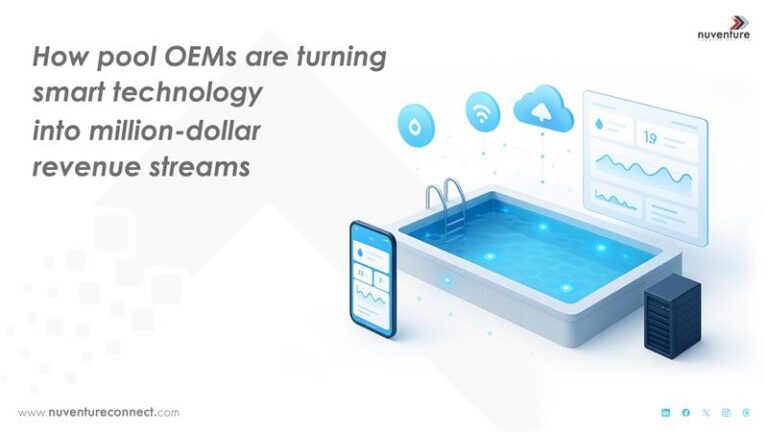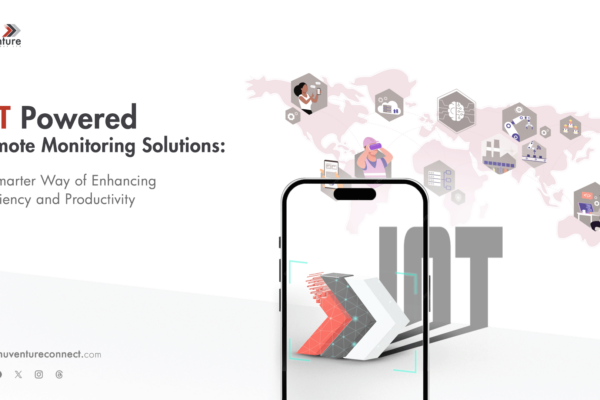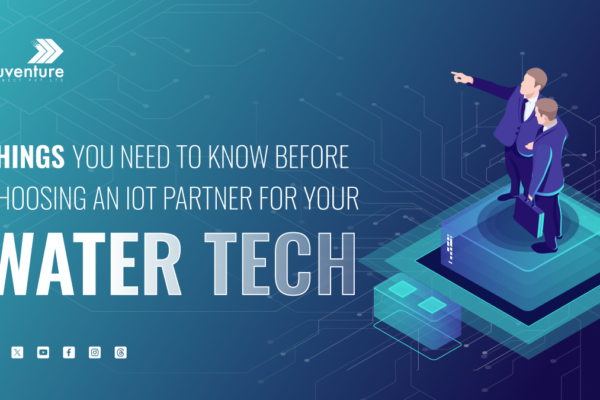The pool industry is experiencing a digital transformation that’s creating unprecedented revenue opportunities for Original Equipment Manufacturers (OEMs). While traditional pool equipment sales remain important, the real gold mine lies in the recurring revenue streams that advanced IoT integration unlocks. Pool OEMs who embrace end-to-end IoT solutions are discovering new ways to monetize their customer relationships through subscription-based monitoring services, predictive maintenance programs, and data-driven insights. With the global pool automation market growing at 5.3% annually and smart pool monitoring systems projected to reach $201.5 million by 2032, forward-thinking OEMs are positioning themselves to capture this lucrative opportunity while their competitors remain stuck in the traditional equipment sales model.
The Revenue Revolution Swimming Pool OEMs Are Missing
Picture this: Your pool equipment company just sold a $15,000 filtration system to a luxury resort chain. That’s great, but what if that same system could generate $3,000 in recurring revenue every year for the next decade? That’s exactly what’s happening in the pool industry right now, and most OEMs are leaving money on the table.
The pool equipment and maintenance market is booming, with projections showing growth from $19.44 billion in 2023 to $42.18 billion by 2030; that’s an impressive 11.7% compound annual growth rate. But here’s the kicker: while the overall market is expanding, the traditional one-time equipment sales model is becoming increasingly commoditized.
Smart pool OEMs are realizing that the real opportunity isn’t just in selling equipment, it’s in creating ongoing relationships with their customers through connected, intelligent systems. The automatic swimming pool monitoring system market alone was valued at $4.29 billion in 2024 and is expected to reach $7.5 billion by 2031. But many equipment manufacturers are still thinking about IoT as a nice-to-have feature rather than a fundamental revenue transformation strategy.
The challenge? Most pool OEMs are treating IoT as an afterthought: a checkbox feature that might help them win a few more deals. They’re missing the bigger picture: IoT isn’t just about making pools “smart,” it’s about creating entirely new business models that generate predictable, recurring revenue streams.
Strategic Insights: The Four Revenue Streams Smart Pool OEMs Are Capitalizing On
1. Subscription-Based Monitoring Services: The Netflix Model for Pool Equipment
Just as Netflix transformed entertainment from a purchase model to a subscription model, smart pool OEMs are doing the same with equipment monitoring. Instead of selling a $5,000 pump and walking away, they’re offering comprehensive monitoring services for $200-500 per month.
These services include real-time water quality monitoring, automated chemical balancing alerts, energy efficiency tracking, and performance optimization. One major pool equipment manufacturer reported that their subscription monitoring service now generates 35% of their total revenue, with margins significantly higher than traditional equipment sales.
The beauty of this model is its predictability. Instead of relying on sporadic equipment replacement cycles, OEMs can count on steady monthly revenue that compounds over time. A customer who might have generated $10,000 in equipment sales over five years can now generate $30,000 or more through ongoing monitoring services.
2. Predictive Maintenance Programs: Preventing Problems Before They Happen
Traditional pool maintenance is reactive, you fix problems after they occur. Smart IoT integration enables predictive maintenance programs that identify potential issues before they become costly failures. This isn’t just better customer service; it’s a significant revenue opportunity.
Pool OEMs are now offering tiered maintenance programs based on predictive analytics. The data tells the story: predictive maintenance programs reduce equipment downtime by up to 40% and extend equipment life by 25%. For customers, this means lower total cost of ownership. For OEMs, it means consistent revenue streams and higher customer lifetime value.
3. Data-Driven Insights and Optimization Services: Turning Information into Revenue
Every connected pool generates thousands of data points daily, water temperature, chemical levels, energy consumption, usage patterns, weather correlations, and more. Smart OEMs are turning this data into valuable insights that customers are willing to pay for.
Commercial pool operators are particularly hungry for this type of intelligence. A hotel chain with 50 pools might pay $1,000 per month for comprehensive analytics that help them optimize energy costs, predict busy periods, and improve guest satisfaction. Municipal aquatic centers use these insights to optimize staffing schedules and reduce operational costs.
The key is packaging data into actionable insights, not just dashboards. OEMs who can demonstrate measurable ROI from their analytics services are commanding premium prices and building stronger customer relationships.
4. Platform-as-a-Service (PaaS) for Pool Management: Becoming the Operating System
The most sophisticated pool OEMs are evolving beyond equipment suppliers to become platform providers. They’re creating comprehensive pool management ecosystems that integrate multiple systems, vendors, and services into a single, unified platform.
This platform approach allows OEMs to capture value from the entire pool ecosystem, not just their own equipment. They might take a percentage of chemical orders placed through their platform, charge transaction fees for maintenance bookings, or earn commissions from partner integrations.
Nuventure’s Perspective: The Single-Team Advantage in IoT Integration
While many pool OEMs are struggling to piece together IoT solutions from multiple vendors, there’s a significant advantage to working with a single team that handles everything from hardware design to cloud infrastructure to mobile applications.
The challenge with the typical multi-vendor approach is that each component works well in isolation, but integration becomes a nightmare. Hardware teams blame software issues, software teams point to connectivity problems, and customers end up with systems that don’t deliver on their promises.
Our experience shows that the most successful pool IoT implementations happen when there’s a single team accountable for the entire solution. This approach eliminates the finger-pointing that often occurs when systems fail, ensures seamless integration between components, and enables rapid iteration based on real-world feedback.
The single-team advantage becomes especially important when OEMs want to launch new revenue streams quickly. Instead of coordinating between multiple vendors to add a new feature or service, they can work with one team that understands the entire ecosystem. This agility is crucial in a fast-moving market where customer expectations are constantly evolving.
At Nuventure, we’ve also developed NuWave, an advanced plug-and-play IoT platform specifically designed for pool operations monitoring that can be customized and deployed from anywhere. What makes NuWave particularly valuable for pool OEMs is its plug-and-play nature. Instead of spending months developing custom IoT solutions, OEMs can leverage our pre-built platform and focus on customizing it for their unique value propositions. Whether it’s monitoring water chemistry, tracking energy consumption, or managing filtration cycles, NuWave provides the foundational infrastructure that makes these revenue streams possible.
From a strategic perspective, this end-to-end approach allows OEMs to focus on what they do best, understanding their customers’ needs and building great products, while partnering with a team that handles the technical complexity of IoT integration.
Future Outlook: The Next Wave of Pool Industry Innovation
The pool industry is entering its most exciting phase of innovation in decades. We’re seeing the emergence of AI-powered pool management systems that can predict optimal chemical dosing based on weather patterns, usage forecasts, and historical data. Machine learning algorithms are getting better at detecting equipment failures weeks before they occur.
The integration of renewable energy systems is creating new opportunities for pool OEMs to offer comprehensive energy management services. Solar-powered pool systems with intelligent energy storage are becoming more cost-effective, and OEMs who can offer these integrated solutions are capturing premium pricing.
Looking ahead, we expect to see the emergence of “pool-as-a-service” models where OEMs take full responsibility for pool performance outcomes. Instead of selling equipment, they’ll guarantee specific performance metrics like energy efficiency, water quality, and uptime. This shift will require sophisticated IoT infrastructure and analytics capabilities, but it represents the ultimate evolution of the recurring revenue model.
The question isn’t whether these changes will happen; they’re already happening. The question is which OEMs will position themselves to capitalize on these opportunities, and which will be left behind in the traditional equipment sales model.
Take Action: Transform Your Pool Business Today
The pool industry’s digital transformation isn’t a future possibility; it’s happening now. OEMs who move quickly to implement comprehensive IoT solutions will capture the most lucrative revenue streams, while those who wait will find themselves competing on price in an increasingly commoditized market.
If you’re ready to explore how advanced IoT integration can unlock new revenue streams for your pool equipment business, let’s start a conversation. We’d love to hear about your current challenges and share insights from other successful pool OEM transformations.
What revenue streams are you most excited about exploring? Share your thoughts in the comments below or reach out directly to discuss how we can help you build a comprehensive IoT strategy that drives sustainable growth.
For more insights on IoT integration strategies specific to pool OEMs, connect with our IoT experts.



